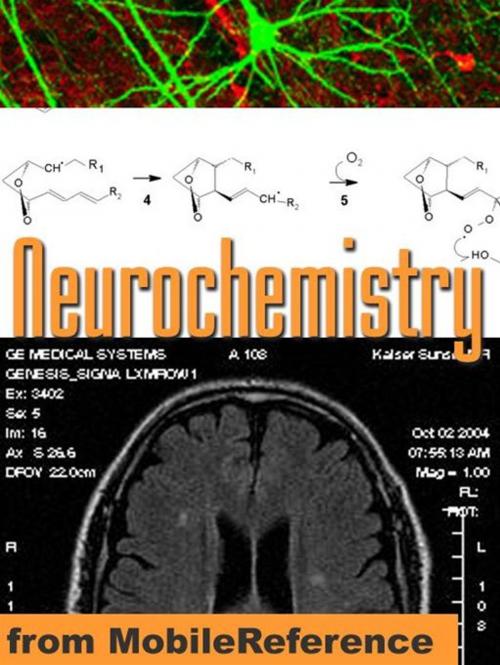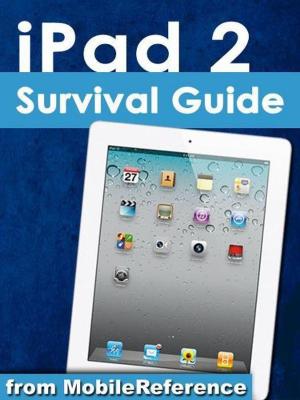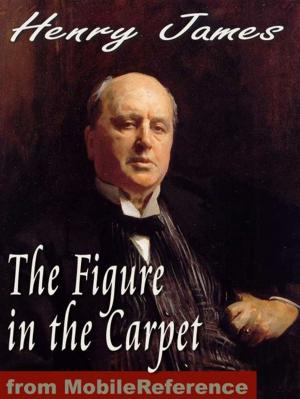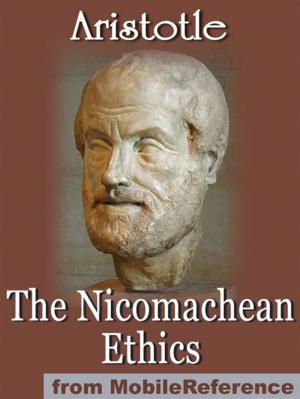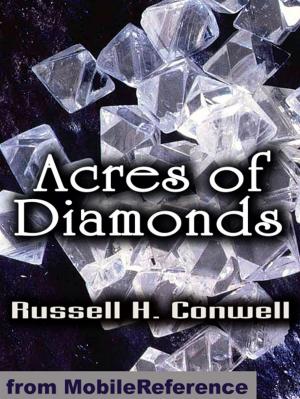Neurochemistry Study Guide: Membranes And Transport, Ion Channels, Extracellular Signaling, Neurotransmitters & More. (Mobi Medical)
Nonfiction, Health & Well Being, Medical, Specialties, Internal Medicine, Neuroscience, Reference & Language, Study Aids, Reference| Author: | MobileReference | ISBN: | 9781605010793 |
| Publisher: | MobileReference | Publication: | January 1, 2010 |
| Imprint: | MobileReference | Language: | English |
| Author: | MobileReference |
| ISBN: | 9781605010793 |
| Publisher: | MobileReference |
| Publication: | January 1, 2010 |
| Imprint: | MobileReference |
| Language: | English |
Neurochemistry Study Guide Audience: Intended for everyone interested in Neurochemistry, particularly undergraduate and graduate life science students, medical students, and nursing students.FEATURES:- Fully illustrated Synthesis and degradation pathways. Written in clear, concise format. Difficult concepts are explained in simple terms. - Navigate from Table of Contents or search for the words or phrases- Access the guide anytime, anywhere - at home, on the train, in the subway. Use your down-time to prepare for an exam. - Always have the guide available for a quick reference. TABLE OF CONTENTS:I. Neurocellular AnatomyNeuron: Axon DendriteAxonal Transport and Growth: Axoplasmic transport Kinesin Dynein Myosin Growth cone Axon guidanceSynapse: Synaptic Vesicles Exocytosis Endocytosis Synaptic plasticity SNARE Synaptobrevin Synapsin NSFGlial cell: Astrocyte Oligodendrocyte Schwann cell Myelin Nodes of Ranvier Multiple sclerosisCytoskeleton: Actin Intermediate filament MicrotubuleII. Membranes And TransportMembrane Structure: Fluid mosaic model Detailed StructureLipids: Fatty acid Fatty acid degradation Fatty acid synthesis Triglyceride Waxes Lipoprotein CholesterolMembrane Components: Phospholipids Sphingomyelin Glycolipid Glycocalix Cholesterol AntigenMovement of Molecules: Diffusion Osmosis Electrochemical gradientPassive transport: Facilitated diffusion Ion channelActive transport: ATP-Dependent Na/K Pump V-ATPase Proton pump Electron transport Antiporter SymporterBlood-brain barrier: Tight junction Cerebrospinal fluidIII. Ion ChannelsChannels: Ion channel Gap junctionVoltage-gated: Potassium channel Sodium channel BK channel Inward-rectifier potassium ion channel Resting channels Calcium channelLigand-gated: NMDA receptor AMPA receptor Kainate receptor Nicotinic acetylcholine receptor Glycine receptor GABA A receptor GABA B receptor GABA C receptorOther ion channels: Cyclic nucleotide-gated Stretch-activated G-protein-gated Light-gatedIV. Extracellular SignalingAcetylcholine: Degradation by acetylcholinesterase Receptors Overview Nicotinic Receptors Muscarinic Receptors Muscarinic receptor agonistCatecholamines: Epinephrine Norepinephrine Norepinephrine transporter Dopamine Dopamine transporter Levodopa Catecholamines breakdown Adrenergic receptor Dopamine receptorMajor dopamine pathways: Mesocortical pathway Nigrostriatal pathway Mesolimbic pathway Tuberoinfundibular pathwaySerotonin: Serotonin transporter Selective serotonin reuptake inhibitor ReceptorsHistamine: H1 receptor H2 receptor H3 receptor H4 receptors Antihistamine drugsGlutamate: NMDA receptor AMPA receptor Kainate receptor Glutamate transporter
Neurochemistry Study Guide Audience: Intended for everyone interested in Neurochemistry, particularly undergraduate and graduate life science students, medical students, and nursing students.FEATURES:- Fully illustrated Synthesis and degradation pathways. Written in clear, concise format. Difficult concepts are explained in simple terms. - Navigate from Table of Contents or search for the words or phrases- Access the guide anytime, anywhere - at home, on the train, in the subway. Use your down-time to prepare for an exam. - Always have the guide available for a quick reference. TABLE OF CONTENTS:I. Neurocellular AnatomyNeuron: Axon DendriteAxonal Transport and Growth: Axoplasmic transport Kinesin Dynein Myosin Growth cone Axon guidanceSynapse: Synaptic Vesicles Exocytosis Endocytosis Synaptic plasticity SNARE Synaptobrevin Synapsin NSFGlial cell: Astrocyte Oligodendrocyte Schwann cell Myelin Nodes of Ranvier Multiple sclerosisCytoskeleton: Actin Intermediate filament MicrotubuleII. Membranes And TransportMembrane Structure: Fluid mosaic model Detailed StructureLipids: Fatty acid Fatty acid degradation Fatty acid synthesis Triglyceride Waxes Lipoprotein CholesterolMembrane Components: Phospholipids Sphingomyelin Glycolipid Glycocalix Cholesterol AntigenMovement of Molecules: Diffusion Osmosis Electrochemical gradientPassive transport: Facilitated diffusion Ion channelActive transport: ATP-Dependent Na/K Pump V-ATPase Proton pump Electron transport Antiporter SymporterBlood-brain barrier: Tight junction Cerebrospinal fluidIII. Ion ChannelsChannels: Ion channel Gap junctionVoltage-gated: Potassium channel Sodium channel BK channel Inward-rectifier potassium ion channel Resting channels Calcium channelLigand-gated: NMDA receptor AMPA receptor Kainate receptor Nicotinic acetylcholine receptor Glycine receptor GABA A receptor GABA B receptor GABA C receptorOther ion channels: Cyclic nucleotide-gated Stretch-activated G-protein-gated Light-gatedIV. Extracellular SignalingAcetylcholine: Degradation by acetylcholinesterase Receptors Overview Nicotinic Receptors Muscarinic Receptors Muscarinic receptor agonistCatecholamines: Epinephrine Norepinephrine Norepinephrine transporter Dopamine Dopamine transporter Levodopa Catecholamines breakdown Adrenergic receptor Dopamine receptorMajor dopamine pathways: Mesocortical pathway Nigrostriatal pathway Mesolimbic pathway Tuberoinfundibular pathwaySerotonin: Serotonin transporter Selective serotonin reuptake inhibitor ReceptorsHistamine: H1 receptor H2 receptor H3 receptor H4 receptors Antihistamine drugsGlutamate: NMDA receptor AMPA receptor Kainate receptor Glutamate transporter
